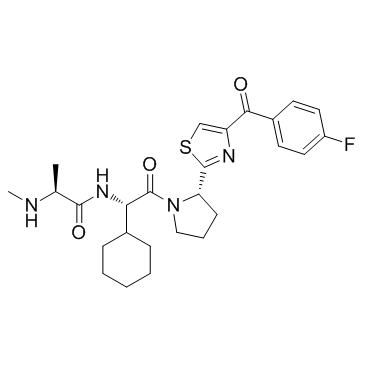| Description |
LCL161 is a IAP inhibitor which inhibits XIAP in HEK293 cell and cIAP1 in MDA-MB-231 cell with IC50s of 35 and 0.4 nM, respectively.
|
| Related Catalog |
|
| Target |
IC50: 35 nM (XIAP, in HEK293 cell), 0.40 nM (cIAP1, in MDA-MB-231)[1]
|
| In Vitro |
LCL161 shows anti-proliferative effects and reduces cell viability significantly in Hep3B (IC50=10.23 μM) and PLC5 (IC50=19.19 μM) cells in a dose-dependent manner. LCL161 induces apoptosis significantly in both the sensitive cell lines in a dose-dependent manner. LCL161 significantly down regulates the expression of cIAP1, starting at very low concentrations. LCL161 at low concentrations inhibits cIAP1 starting at the concentration of 0.5 nM[2]. LCL161 is a small molecule oral IAP antagonist in development for use in combination with cytotoxic agents. The effect of LCL161 on CYP3A4/5 (CYP3A) activity is investigated in vitro. Results in human liver microsomes indicated LCL161 inhibited CYP3A in a concentration- and time-dependent manner (KI of 0.797 µM and Kinact of 0.0803 min-1). LCL161 activates human PXR in a reporter gene assay and induced CYP3A4 mRNA up to ~5-fold in human hepatocytes[3].
|
| In Vivo |
Tumor-bearing mice are treated with vehicle or LCL161 p.o. at a dose of 50 mg/kg/day, or SC-2001 p.o. at a dose of 10 mg/kg/day, 5 days a week, or in combination for the duration of the study. Tumor growth is significantly inhibited by co-treatment with SC2001 and LCL161 and tumor size in the co-treatment group is only one third of that of the control group at the end of the study[2]. LCL161 is a first-in-class oral Smac mimetic shown to induce degradation of cIAP1 and cleavage of caspase 3 in mouse xenograft models[4].
|
| Kinase Assay |
CYP3A activity is assessed using the probe reactions, midazolam-1′-hydroxylation and testosterone 6β-hydroxylation. For reversible inhibition, incubations (37°C, 10 min) are composed of (final concentrations): potassium phosphate buffer (100 mM, pH 7.4), β-NADPH (1 mM), magnesium chloride (5 mM), microsomal protein (0.025 mg/mL), probe substrate (1 µM midazolam or 25 µM testosterone), LCL161 (0, 0.5, 1, 5, 10, 25, 50, or 100 µM) and organic solvent (0.2% acetonitrile for midazolam, 0.2% methanol for testosterone). After a 3-minute preincubation, the reactions are initiated by addition of β-NADPH and terminated by addition of acetonitrile (two volumes). Reactions are previously shown to be linear with respect to time and protein concentration (results not shown) with midazolam and testosterone turnover of 8.7±1.3% (n=3) and 2.6±0.20%, respectively. Formation of 1′-hydroxymidazolam and 6β-hydroxytestosterone is determined by LC-MS/MS as described below[3].
|
| Cell Assay |
Cells are plated (3×104 viable cells/well) in 96-well clear bottom white plates and the plates are incubated for ~24 hours at 37°C (5% CO2/95% air) in a humidified incubator. The cells (six replicate wells) are then treated with various concentrations (0.5, 1, 2.5, 5, 10, 25, or 50 µM) of LCL161, the positive control, Rifampin (RIF), or vehicle control (0.1% DMSO, final concentration) for 24 hours in Puracyp dosing media. After the incubation period, the cells are washed with PBS, lysed and the luciferase substrate is added according to the vendor instructions. An aliquot of each well is transferred to the identical wells of black 96-well plates. The luminescence of each well is measured with a TopCount NXT Microplate Scintillation and Luminescence Counter. Cell viability is measured in separate plates treated identically to the PXR-reporter gene assay plates by measurement of ATP content of the cells using the CellTiter-Glo® Luminescent Cell Viability Assay kit. Cell viability is >80% for all treatments[3].
|
| Animal Admin |
Mice[2] Male NCr athymic nude mice (5-7 weeks of age) are used. Each mouse is inoculated s.c. in the dorsal flank with 1×106 Huh-7 cells suspended in 0.1 mL of serum-free medium containing 50% Matrigel. When tumors reach 200-300 mm3, mice receives LCL161 (50 mg/kg) or SC-2001 (10 mg/kg) p.o., or a combination of LCL161 and SC-2001, once daily. Controls receive vehicle. Tumors are measured weekly using calipers and their volumes calculated using the following standard formula: width2×length×0.52. LCL161 is a first-in-class oral Smac mimetic shown to induce degradation of cIAP1 and cleavage of caspase 3 in mouse xenograft models . Rats[4] LCL161 is administered orally, once weekly in 21-day cycles, at a starting dose of 10 mg (calculated by using one tenth of the dose that caused severe toxicity in 10% of rats and converted to a human-equivalent dose). In the MDA-MB-231 triple-negative breast cancer xenograft model, once-weekly and twice-daily LCL161 dosing are similarly efficacious. Once weekly is better tolerated, with reduced weight loss.
|
| References |
[1]. Maria Ahn, et al. Potent, Dual cIAP1/XIAP Antagonists Induce Apoptosis in a Melanoma Stem Cell Population [2]. Chen KF, et al. Inhibition of Bcl-2 improves effect of LCL161, a SMAC mimetic, in hepatocellular carcinoma cells. Biochem Pharmacol. 2012 Aug 1;84(3):268-77. [3]. Dhuria S, et al. Time-dependent inhibition and induction of human cytochrome P4503A4/5 by an oral IAP antagonist, LCL161, in vitro and in vivo in healthy subjects. J Clin Pharmacol. 2013 Jun;53(6):642-53. [4]. Infante JR, et al. Phase I dose-escalation study of LCL161, an oral inhibitor of apoptosis proteins inhibitor, in patients with advanced solid tumors. J Clin Oncol. 2014 Oct 1;32(28):3103-10.
|

 CAS#:1005342-82-4
CAS#:1005342-82-4